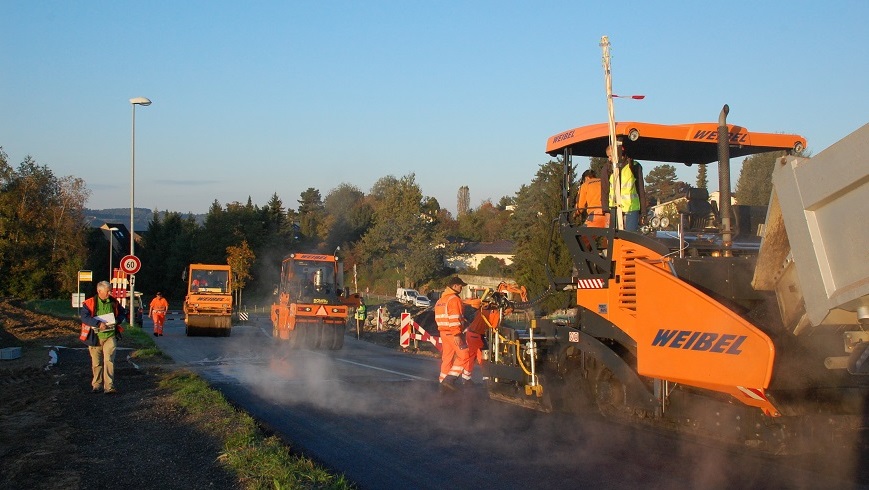Asphalt with fewer emissions
Better work climate in road construction
Sweltering heat, hot fumes and noisy machines - asphalting roads is hard work. Empa researchers have analysed whether and how much harmful emissions are produced when regular "hot asphalt" or so-called warm asphalt is laid. The result: the more ecological warm asphalt also outperforms the conventional method in terms of emissions.

Asphalt is a hot thing: it is normally mixed at 160°C, transported and then laid by the road builders at around 150°C. This is not only a burden for the workers; the ecological footprint of asphalt is also immense due to the high energy consumption and the resulting CO2 emissions. One solution is the so-called warm asphalt. It is only heated to 140°C and laid at even lower temperatures. This makes it much more pleasant for the workers and even less energy-intensive.
Empa researchers have now shown in a study that different types of warm asphalt are not only ahead of normal hot asphalt in terms of ecology and work environment. The harmful emissions are also significantly lower when hot asphalt is laid. Depending on the binder in the asphalt, pollutants are present in various quantities - including polycyclic aromatic hydrocarbons (PAH), which are naturally present in small concentrations in coal and crude oil. Large quantities of PAHs are contained in tar, which has been used in road construction for many years. By recycling these tar-containing pavements, it entered the recycling cycle in the form of asphalt granulate - and releases PAH when heated again. Bitumen is now used instead of tar in road construction. However, this also entails an emission risk: volatile organic hydrocarbons (TVOC) are produced by the evaporation of low-liquid bitumen components and the decomposition reaction of bitumen at high temperatures. The following applies to both pollutants: the lower the temperature during production and processing, the less pollutants are released into the air.
Field research on the road
The analyses took place directly at the scene of the event. Kerstin Zeyer and Joachim Mohn from Empa's "Air Pollution / Environmental Technology" lab equipped machines and construction workers with measuring systems that record emissions directly at the point of origin. For each type of asphalt examined (a total of four types of warm asphalt and one conventional asphalt), the workers laid two kilometres of road and collected data. This was a time-consuming task, as all the equipment had to be replaced after each section. In addition to field research, the team also carried out laboratory tests to check the plausibility of the field measurements - and came to the same conclusion. A total of 90% fewer total particles were emitted by the warm asphalt compared to the regular asphalt and 50-70% fewer volatile organic hydrocarbons were measured. However, all emission values - regardless of the type of asphalt - are well below the level harmful to workers.
With this excellent record in terms of ecology and health at work, the question arises as to why Switzerland has not long since switched to warm asphalt. "Unfortunately, this is not so easy," explains Martin Hugener of Empa's Road Construction / Waterproofing Department. "Because all production plants are still designed for the production of regular hot asphalt. In concrete terms, the burners of the mixing plants would have to be optimized everywhere in order to be able to produce warm asphalt on a large scale.
Recycling asphalt undergoing practical testing
Road construction is very resource-intensive and causes considerable CO2 emissions. An international research project of the Community Initiative of the European Regional Development Fund (Interreg) wants to change this. Within the framework of the ORRAP project ("Optimal recycling of recycled asphalt on roads with little traffic"), methods are to be developed for better recycling of asphalt and correspondingly less pollution of the environment. Empa researchers led by Christiane Raab from the "Road Construction / Waterproofing" lab have developed a new process for this purpose. Only water is added to the granular asphalt and the material is then compacted by rolling. In order to keep emissions as low as possible, the asphalt is also laid "cold". The researchers in Wahlen in the canton of Basel-Land have thus had a test track asphalted whose base layer consists of pure cold recycled asphalt laid. This road section will be used normally until next summer. The researchers will then evaluate how well the newly rolled asphalt will hold if no rejuvenating or binding agents are added.
Dr. Martin Hugener
Road Engineering/Sealing Components
Phone +41 58 765 44 87
Kerstin Zeyer
Air Pollution / Environmental Technology
Phone +41 58 765 45 38
Dr. Joachim Mohn
Air Pollution / Environmental Technology
Phone +41 58 765 46 87
Road Engineering/Sealing Components
Phone +41 58 765 44 83
M Hugener, K Zeyer, J Mohn; Reduced emissions of warm mix asphalt during construction; Road Materials and Pavement Design (2019); DOI: 10.1080/14680629.2019.1628426
-
Share





